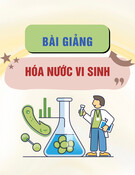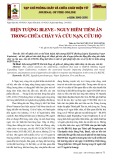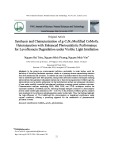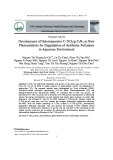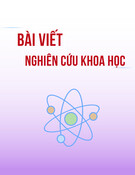
TNU Journal of Science and Technology
229(06): 32 - 40
http://jst.tnu.edu.vn 32 Email: jst@tnu.edu.vn
DISTRIBUTION AND GEOCHEMISTRY OF LEAD IN TIDAL CREEK
SEDIMENT IMPACTED BY ANTHROPOGENIC ACTIVITIES
Le Quang Huy1, 2, To Thi Hong Chuyen1, Nguyen Van Dong1, Le Thi Huynh Mai1, Nguyen Thanh Nho2*
1University of Science - Vietnam National University, Ho Chi Minh City
2Institute of Applied Technology and Sustainable Development - Nguyen Tat Thanh University
ARTICLE INFO
ABSTRACT
Received:
28/11/2023
Mangrove-dominated estuaries could play an important role in
mitigating pollutants from the land to the sea. However, changes in the
physicochemical characteristics of water and sediment could affect the
spatiotemporal distribution of pollutants, including heavy metals which
may induce ecological risks to organisms during tidal cycles and
seasons. In the present study, we aimed to evaluate the lead (Pb)
partitioning and its ecological risks in tidal creek sediments within the
Can Gio mangrove estuary by using a method of sequential extraction.
The results shown that the total lead content ranged from 16.92 – 24.55
mg/kg. We suggest that Pb originated mainly from natural sources
during the weathering process that could be supported by Pb
partitioning in residual fraction – silicate bonding i.e., F4 > F3 > F2 >
F1 and geoaccumulation index (Igeo) < 0. The risk assessment code
(RAC) was less than 10% at the sampling sites which indicated low
ecological risks and anthropogenic activities were minor factors that
may influence Pb geochemistry.
Revised:
22/3/2024
Published:
22/3/2024
KEYWORDS
Lead
Sequential extraction
Metal
Sediment
Can Gio
PHÂN BỐ VÀ ĐỊA HÓA CỦA CHÌ TRONG TRẦM TÍCH KÊNH RẠCH
BỊ ẢNH HƯỞNG BỞI HOẠT ĐỘNG DÂN SINH
Lê Quang Huy1, 2, Tô Thị Hồng Chuyên1, Nguyễn Văn Đông1, Lê Thị Huỳnh Mai1, Nguyễn Thành Nho2*
1Trường Đại học Khoa học Tự nhiên - ĐH Quốc gia Thành phố Hồ Chí Minh
2Viện Ứng dụng công nghệ và Phát triển bền vững - Trường Đại học Nguyễn Tất Thành
THÔNG TIN BÀI BÁO
TÓM TẮT
Ngày nhận bài:
28/11/2023
Các cửa sông có rừng ngập mặn đóng vai trò quan trọng giảm thiểu chất
ô nhiễm từ đất liền ra biển. Tuy nhiên, những thay đổi về tính chất hóa
lý của nước và trầm tích có thể ảnh hưởng đến sự phân bố của chất ô
nhiễm theo thời gian và không gian, bao gồm cả kim loại nặng, chúng
có thể gây ra rủi ro sinh thái cho sinh vật theo thủy triều và mùa. Trong
nghiên cứu này, chúng tôi sử dụng phương pháp chiết tuần tự các phân
đoạn hóa học để đánh giá sự phân bố của chì (Pb) và rủi ro sinh thái
trong trầm tích ở các con rạch bị ảnh hưởng bởi chế độ thủy triều vùng
cửa sông có rừng ngập mặn Cần Giờ. Kết quả cho thấy hàm lượng chì
tổng số dao động trong khoảng 16.92 – 24.55 mg/kg, có nguồn gốc chủ
yếu từ các nguồn tự nhiên được phóng thích và tích lũy trong quá trình
phong hóa. Kết luận này có thể được chứng minh qua hàm lượng Pb
liên kết chủ yếu với khoáng silicate – F4, cụ thể F4 > F3 > F2 > F1 và
chỉ số tích lũy địa lý (Igeo) < 0. Mã đánh giá rủi ro (RAC) < 10% tại
các điểm lấy mẫu cho thấy rủi ro sinh thái của Pb ở mức thấp và các
hoạt động nhân sinh không phải là nhân tố chính có thể ảnh hưởng đến
địa hóa học của Pb.
Ngày hoàn thiện:
22/3/2024
Ngày đăng:
22/3/2024
TỪ KHÓA
Chì
Chiết tuần tự
Kim loại
Trầm tích
Cần Giờ
DOI: https://doi.org/10.34238/tnu-jst.9301
* Corresponding author. Email: ntnho@ntt.edu.vn





